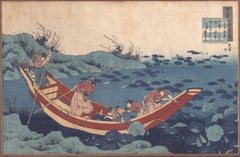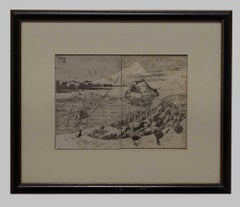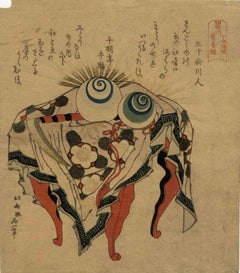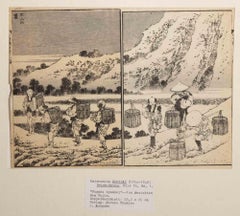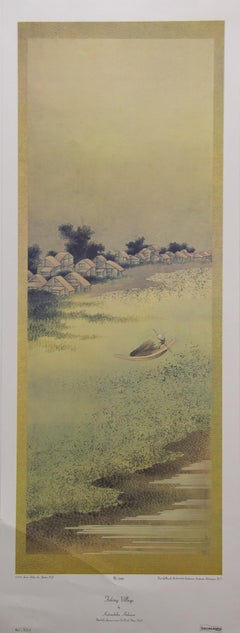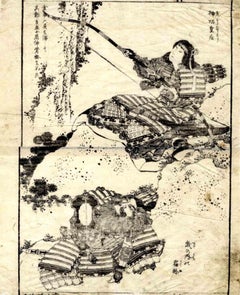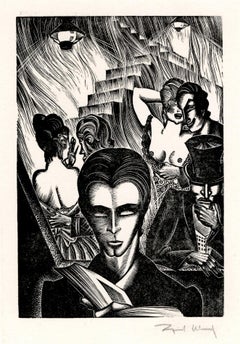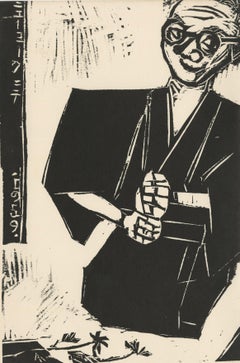Katsushika Hokusai Art
to
4
8
3
1
1
9
3
9
2
1
Overall Height
to
Overall Width
to
8
9
6
5
4
3
2
2
1
1
1
1
1
1
1
1
10
2
12
6,996
3,348
2,513
1,213
11
1
1
1
Artist: Katsushika Hokusai
Katsushika Hokusai -- POEM BY BUNYA NO ASAYASU (FUMIYA NO ASAYASU) 百人一首
By Katsushika Hokusai
Located in BRUCE, ACT
Katsushika Hokusai (Japanese, 1760–1849)
Poem by Bunya no Asayasu (Fumiya no Asayasu), from the series One Hundred Poems Explained by the Nurse (Hyakunin isshu uba ga etoki)
「百人一首うはか...
Category
1830s Katsushika Hokusai Art
Materials
Woodcut
View of Mount Fuji in Winter- Woodcut by Katsushika Hokusai - Early 20th century
By Katsushika Hokusai
Located in Roma, IT
View of Mount Fuji in Winter is a woodcut print realized by Katsushika Hokusai in the early 19th Century, probably around 1835.
From the book "Fugaku hyakkei" (100 views of Mount Fu...
Category
Early 20th Century Modern Katsushika Hokusai Art
Materials
Woodcut
Surimono - Woodcut Print by Katsushika Hokusai - 19t Century
By Katsushika Hokusai
Located in Roma, IT
Surimono copy B or C (Kakuban) is an original modern artwork realized by Katsushika Hokusai in Late 19th Century.
Chinese lacquer table with cloth, sickle and Buddhist jewels.
Sign...
Category
19th Century Modern Katsushika Hokusai Art
Materials
Woodcut
Landscape from Fugaku Hyakkei-Woodcut Print by Katsushika Hokusai-1878
By Katsushika Hokusai
Located in Roma, IT
Landscape from "Fugaku hyakkei" is an original modern artwork realized after Katsushika Hokusai (31 October 1760 – 10 May 1849).
Original Woodcut print from the series "Fugaku hyakkei" (100 views of Mount Fuji). From the second posthumous edition 1878.
Passepartout is included.
Publisher Eiraku Toshiro.
Sheet dimensions: 24 x 26 cm.
Good conditions. Signs of age and wear.
Hokusai created the monumental Thirty-Six Views of Mount Fuji both as a response to a domestic travel boom in Japan and as part of a personal obsession with Mount Fuji.
Landscape from "Fugaku hyakkei" is an original modern artwork realized by Katsushika Hokusai (31 October 1760 – 10 May 1849) in the Second half of the XIX Century. Katsushika Hokusai (31 October 1760 – 10 May 1849) known simply as Hokusai, was a Japanese artist, ukiyo-e painter and printmaker of the Edo period. Hokusai is best known for the woodblock print series Thirty-Six Views of Mount Fuji which includes the internationally iconic print The Great Wave off Kanagawa...
Category
19th Century Modern Katsushika Hokusai Art
Materials
Woodcut
"Fishing Village" by Katsushika Hokusai. Printed in U.S.A.
By Katsushika Hokusai
Located in Clinton Township, MI
Aaron Ashley, Inc.
Printed in USA
Good/fair condition (creasing and staining in bottom left corner)
37 x 14 in.
Category
20th Century Katsushika Hokusai Art
Materials
Lithograph
The Stirrups of Musashi- Original Woodcut Print by Katsushika Hokusai - 1836
By Katsushika Hokusai
Located in Roma, IT
The Stirrups of Musashi is an original modern artwork realized by Katsushika Hokusai in 1836.
Mushae (double page, book 1836).
B/W print. From the book "Ehon Musashi abumi" (The St...
Category
19th Century Modern Katsushika Hokusai Art
Materials
Woodcut
Landscape from Fugaku Hyakkei- Woodcut Print by Katsushika Hokusai-1878
By Katsushika Hokusai
Located in Roma, IT
Landscape from "Fugaku hyakkei" is an original modern artwork realized by Katsushika Hokusai (31 October 1760 – 10 May 1849).
Original Woodcut print from the series "Fugaku Hyakkei" (100 views of Mount Fuji). From the second posthumous edition 1878.
Passepartout is included.
Publisher Eiraku Toshiro.
Sheet dimensions: 24 x 26 cm.
Good conditions. Signs of age and wear.
Hokusai created the monumental Thirty-Six Views of Mount Fuji both as a response to a domestic travel boom in Japan and as part of a personal obsession with Mount Fuji.
Katsushika Hokusai (31 October 1760 – 10 May 1849) known simply as Hokusai, was a Japanese artist, ukiyo-e painter and printmaker of the Edo period. Hokusai is best known for the woodblock print series Thirty-Six Views of Mount Fuji which includes the internationally iconic print The Great Wave off Kanagawa...
Category
19th Century Modern Katsushika Hokusai Art
Materials
Woodcut
Fugaku Hyakkei - Woodcut Print by Katsushika Hokusai - Early 19th Cent.
By Katsushika Hokusai
Located in Roma, IT
Plate from Fugaku Hyakkei is a modern artwork realized by Katsushika Hokusai in the early 19th century.
Woodcut orint double page of book.
Black and white print with grey. From the...
Category
19th Century Modern Katsushika Hokusai Art
Materials
Woodcut
Landscape from Fugaku Hyakkei- Woodcut Print by Katsushika Hokusai-1878
By Katsushika Hokusai
Located in Roma, IT
Landscape from "Fugaku Hyakkei" is an original modern artwork realized by Katsushika Hokusai (31 October 1760 – 10 May 1849).
Original Woodcut print from the series "Fugaku hyakkei"...
Category
19th Century Modern Katsushika Hokusai Art
Materials
Woodcut
Farmers Eating - Woodcut Print by Katsushika Hokusai - 1814
By Katsushika Hokusai
Located in Roma, IT
Farmers Eating is an original modern artwork realized by Katsushika Hokusai in 1814.
Woodcut print double page of a book.
B/W print with light gray and red. From one of the manga v...
Category
19th Century Modern Katsushika Hokusai Art
Materials
Woodcut
Construction #2
By Katsushika Hokusai
Located in Florham Park, NJ
FUGAKU HYAKKEI
(Views of Mt. Fuji)
Katsushika Hokusai (1760-1849)
Woodblock Print
1834-5 Edo period
It signifies the long history and the aspirations of the race; it is a tok...
Category
Early 19th Century Academic Katsushika Hokusai Art
Materials
Woodcut
Men on the Mountain
By Katsushika Hokusai
Located in Florham Park, NJ
FUGAKU HYAKKEI
Views of Mt. Fuji
Katsushika Hokusai (1760-1849)
Woodblock Print
1834-5 Edo period
It signifies the long history and the aspirations of the race; it is a token ...
Category
Mid-19th Century Academic Katsushika Hokusai Art
Materials
Woodcut, Watercolor
Related Items
'Madman's Drum (Plate 41)' — 1930s Graphic Modernism
By Lynd Ward
Located in Myrtle Beach, SC
Lynd Ward, 'Madman's Drum, Plate 41', wood engraving, 1930, edition small. Signed in pencil. A fine, black impression, on off-white tissue-thin Japan paper; the full sheet with margins (1 5/8 to 2 1/2 inches); a small paper blemish in the upper right margin, away from the image, otherwise in excellent condition. Scarce. Matted to museum standards, unframed.
Image size 5 1/2 x 3 3/4 inches (140 x 95 mm); sheet size 9 5/8 x 7 1/8 inches (244 x 181 mm).
From Lynd Ward’s book of illustrations without words, 'Madman’s Drum', Jonathan Cape and Harrison Smith, New York, 1930. Illustrated in 'Storyteller Without Words: The Wood Engravings of Lynd Ward', Harry Abrams, New York, 1974.
Reproduced in 'Storyteller Without Words, the Wood Engravings of Lynd Ward', Harry N. Abrams, New York, 1974.
ABOUT THE ARTIST
Lynd Ward is acknowledged as one of America’s foremost wood engravers and book illustrators of the first half of the twentieth century. His innovative use of narrative printmaking as a stand-alone storytelling vehicle was uniquely successful in reaching a broad audience. The powerful psychological intensity of his work, celebrated for its dynamic design, technical precision, and compelling dramatic content, finds resonance in the literature of Poe, Melville, and Hawthorne. Like these classic American writers, Ward was concerned with the themes of man’s inner struggles and the role of the subconscious in determining his destiny. An artist of social conscience during the Great Depression and World War II, he infused his graphic images with his unique brand of social realism, deftly portraying the problems that challenged the ideals of American society.
The son of a Methodist preacher, Lynd Ward, moved from Chicago to Massachusetts at an early age. He graduated from the Teachers College of Columbia University, New York, in 1926, where he studied illustration and graphic arts. He married May Yonge McNeer in 1936 and left for Europe for their honeymoon in Eastern Europe. After four months, they settled in Leipzig, where Ward studied at the National Academy of Graphic Arts and Bookmaking. Inspired by Belgian expressionist artist Frans Masereel's graphic novel ‘The Sun,’ and another graphic novel by the German artist Otto Nückel, ‘Destiny,’ he determined to create his own "wordless" novel. Upon his return to America, Ward completed his first book, ‘God's Man: A Novel in Woodcuts,’ published in 1929. ‘Gods’ Man’ was a great success for its author and publisher and was reprinted four times in 1930, including a British edition. This book and several which followed it, ‘Madman’s Drum,’ 1930, ‘Wild Pilgrimage...
Category
1930s American Modern Katsushika Hokusai Art
Materials
Woodcut
At New York (Self Portrait)
By Shiko Munakata
Located in Fairlawn, OH
At New York (Self Portrait)
Woodcut, 1961
Unsigned (as issued)
From: The "Way" of the Woodcut, three woodcuts, 1961
Publisher: Pratt Adlib Press, Brooklyn, New York,1961
Printer: Jam...
Category
1960s Modern Katsushika Hokusai Art
Materials
Woodcut
No Footprints Show, Where the Flowers Grow Deep
By Shiko Munakata
Located in Fairlawn, OH
No Footprints Show, Where the Flowers Grow Deep
Woodcut, 1961
Unsigned (as isssued)
From: The "Way" of the Woodcut, three woodcuts, 1961
Publisher: Pratt Adlib Press, Brooklyn, New Y...
Category
1960s Modern Katsushika Hokusai Art
Materials
Woodcut
3 Turns - Surfing Art - Figurative Print - Woodcut Print By Marc Zimmerman
By Marc Zimmerman
Located in Carmel, CA
Three surfers carving up the Hawaiian waves, having a blast in the tropical surf.
3 Turns - Surfing Art - Figurative Print - Woodcut Print By Marc Zimmerman
Limited Edition 01/05
...
Category
2010s American Modern Katsushika Hokusai Art
Materials
Woodcut
Picasso, Composition (Johnson, Vollard 193), Hélène chez Archimède (after)
By Pablo Picasso
Located in Auburn Hills, MI
Woodcut Engraving on cream wove Montval paper. Unsigned and unnumbered, as issued. Good Condition; never framed or matted. Notes: From the volume, Hélène Chez Archimède, 1955. Publis...
Category
1950s Modern Katsushika Hokusai Art
Materials
Woodcut
No Reserve
H 17.25 in W 13 in
Picasso, Composition (Johnson, Vollard 193), Hélène chez Archimède (after)
By Pablo Picasso
Located in Auburn Hills, MI
Woodcut Engraving on cream wove Montval paper. Unsigned and unnumbered, as issued. Good Condition; never framed or matted. Notes: From the volume, Hélène Chez Archimède, 1955. Publis...
Category
1950s Modern Katsushika Hokusai Art
Materials
Woodcut
No Reserve
H 17.25 in W 13 in
"Lendas Africanas Da Bahia" from the suite.
Located in San Francisco, CA
This artwork titled " Lendas Africanas Da Bahia" from the suite, 1978, is an original colors woodcut by renown Brazilian/Argentinian artist Hector Julio Paride Barnabo Carybe, 1911-1997. It is hand signed and numbered 83/200 in pencil by the artist. The Wood block mark (image) is 23.65 x 15.75 inches, sheet size is 26.75 x 19 inches. It is in excellent condition, has never been framed. It will be shipped in a 8 inches diameter heavy duty tube.
About the artist:
Héctor Julio Páride Bernabó (7 February 1911 – 2 October 1997) was an Argentine-Brazilian artist, researcher, writer, historian and journalist. His nickname and artistic name, Carybé, a type of piranha, comes from his time in the scouts. He died of heart failure after the meeting of a candomblé community's lay board of directors, the Cruz Santa Opô Afonjá Society, of which he was a member.
Quick Facts Born, Died ...
Carybé
Born
Héctor Julio Páride Bernabó
7 February 1911
Lanús, Argentina
Died
2 October 1997 (aged 86)
Salvador, Bahia, Brazil
Nationality
Brazilian
Known for
Painter, engraver, draughtsman, illustrator, potter, sculptor, mural painter, researcher, historian and journalist
Close
He produced thousands of works, including paintings, drawings, sculptures and sketches. He was an Obá de Xangô, an honorary position at Ilê Axé Opô Afonjá.
Orixá Panels in the Afro-Brazilian Museum in Salvador
Some of Carybé's work can be found in the Afro-Brazilian Museum in Salvador: 27 cedar panels representing different orixás or divinities of the Afro-Brazilian religion candomblé. Each panel shows a divinity with their associated implements and animal. The work was commissioned by the former Banco da Bahia S.A., now Banco BBM S.A., which originally installed them in its branch on Avenida Sete de Setembro in 1968.
Murals at Miami International Airport
American Airlines, Odebrecht and the Miami-Dade Aviation Department partnered to install two of Carybé's murals at Miami International Airport. They have been displayed in the American Airlines terminal at John F. Kennedy International Airport in New York since 1960. The 16.5 x 53-foot murals were accredited when Carybé won the first and the second prize in a contest of public art pieces for JFK airport.
As its terminal at that airport was due for demolition, American Airlines donated the murals to Miami-Dade County, and Odebrecht invested in a project to remove, restore, transport and install the murals at Miami International Airport.
The mural "Rejoicing and Festival of the Americas" portrays colorful scenes from popular festivals throughout the Americas, and "Discovery and Settlement of the West" depicts the pioneers’ journey into the American West.
Carybé's Woodcuts in Gabriel García Márquez's Books
Carybé illustrated four books by the Colombian writer Gabriel García Márquez, including One Hundred Years of Solitude, The Autumn of the Patriarch, Chronicle of a Death Foretold, and Love in the Time of Cholera "Carybé: um mestre da cultura baiana". ArqBahia Arquitetura, design, arte e lifestyle (in Brazilian Portuguese). 26 April 2023.. In particular, the woodcuts in One Hundred Years of Solitude are well-known for providing a visual image of the fictional town of Macondo, where the story takes place. The illustrations depict the colorful and winding houses, the railway bridge, and the hot and humid climate of the region, contributing to the reader's immersion in the story.
Carybé's woodcuts are, therefore, an important part of Gabriel García Márquez's literary legacy, bringing a visual dimension to his stories that further enriches the reader's experience.
Timeline
1911 — Birth in Lanús, Argentina.
1919 — Moved to Brazil.
1921 — The name Carybé is first given to him by the Clube do Flamengo scouts group, in Rio de Janeiro.
1925 — Beginning of his artistic endeavours, going to the pottery workshop of his elder brother, Arnaldo Bernabó, in Rio de Janeiro.
1927–1929 — Studies at the National School of Fine Arts, in Rio de Janeiro.
1930 — Worked for the newspaper Noticias Gráficas, in Buenos Aires, Argentina.
1935–1936 — Works with the writer Julio Cortázar and as a draughtsman for the El Diario newspaper.
1938 — Sent to Salvador by newspaper Prégon.
1939 — First collective exhibition, with the artist Clemente Moreau, at the Buenos Aires City Museum of Fine Arts, Argentina; illustrates the book Macumba, Relatos de la Tierra Verde, by Bernardo Kardon, published by Tiempo Nuestro.
1940 — Illustrates the book Macunaíma, by Mário de Andrade.
1941 — Draws the Esso Almanach, the payment for which allows him to set on a long journey through Uruguay, Brazil, Bolivia, and Argentina.
1941–1942 — Study trip around several South American countries.
1942 — Illustration for the book La Carreta by Henrique Amorim, published by El Ateneo (Buenos Aires, Argentina).
1943 — Together with Raul Brié, translates the book Macunaíma, by Mário de Andrade, into Spanish; produces the illustrations for the works Maracatu, Motivos Típicos y Carnavalescos, by Newton Freitas, published by Pigmaleon, Luna Muerta, by Manoel Castilla, published by Schapire, and Amores de Juventud, by Casanova Callabero; also publishes and illustrates Me voy al Norte, for the quarterly magazine Libertad Creadora; awarded First Prize by the Cámara Argentina del Libro (Argentine Book Council) for the illustration of the book Juvenília, by Miguel Cané (Buenos Aires, Argentina).
1944 — Illustrates the books The Complete Poetry of Walt Whitmann and A Cabana do Pai Tomás, both published by Schapire ; as well as and Los Quatro Gigantes del Alma by Mira y Lopez, Salvador BA; attends capoeira classes, visits candomblé meetings and makes drawings and paintings.
1945 — Does the illustrations for Daniel Defoe's Robinson Crusoe, for the Viau publishing house.
1946 — Helps in setting up the Tribuna da Imprensa newspaper, in Rio de Janeiro.
1947 — Works for the O Diário Carioca newspaper, in Rio de Janeiro.
1948 — Produces texts and illustrations for the book Ajtuss, Ediciones Botella al Mar (Buenos Aires, Argentina).
1949–1950 — Invited by Carlos Lacerda to work at the Tribuna da Imprensa, in Rio de Janeiro.
1950 — Invited by the Education Secretary Anísio Teixeira, moves to Bahia, and produces two panels for the Carneiro Ribeiro Education Center (Park School), in Salvador, Bahia.
1950–1997 — Settles in Salvador, Bahia.
1950–1960 — Actively participate in the plastic arts renewal movement, alongside Mário Cravo Júnior, Genaro de Carvalho, and Jenner Augusto.
1951 — Produces texts and illustrations for the works of the Coleção Recôncavo, published by Tipografia Beneditina and illustrations for the book, Bahia, Imagens da Terra e do Povo, by Odorico Tavares, published by José Olímpio in Rio de Janeiro; for the latter work he receives the gold medal at the 1st Biennial of Books and Graphic Arts.
1952 — Makes roughly 1,600 drawings for the scenes of the movie O Cangaceiro, by Lima Barreto; also works as the art director and as an extra on the film (São Paulo, SP).
1953 — Illustrations for the book A Borboleta Amarela, by Rubem Braga, published by José Olímpio (Rio de Janeiro, RJ).
1955 — Illustrates the work O Torso da Baiana, edited by the Modern Art Museum of Bahia.
1957 — Produces etchings, with original designs, for the special edition of Mário de Andrade's Macunaíma, published by the Sociedade dos 100 Bibliófilos do Brasil.
1958 — Makes an oil painting mural for the Petrobras Office in New York, USA; illustrates the book As Três Mulheres de Xangô, by Zora Seljan, published by Editora G. R. D. (Rio de Janeiro, RJ); Receives a scholarship grant in New York, USA.
1959 — Takes part in the competition for the New York International Airport panels project, in New York, USA, winning first and second prizes.
1961 — Illustrates the book Jubiabá, by Jorge Amado, published by Martins Fontes (São Paulo, SP).
1963 — Awarded the title of Honorary Citizen of Salvador, Bahia.
1965 — Illustrates A Muito Leal e Heróica Cidade de São Sebastião do Rio de Janeiro, published by Raymundo Castro Maya (Rio de Janeiro, RJ).
1966 — With Jorge Amado, co-authors Bahia, Boa Terra Bahia, published by Image (Rio de Janeiro, RJ); writes and illustrates the book Olha o Boi, published by Cultrix (São Paulo, SP).
1967 — Receives the Odorico Tavares Prize – Best Plastic Artist of 1967, in a competition ran by the state government to stimulate the development of plastic arts in Bahia; makes the Orixás Panels for the Banco da Bahia (currently at the UFBA Afro-Brazilian Museum) (Salvador, BA).
1968 — Illustrates the books Carta de Pero Vaz de Caminha ao Rei Dom Manuel, published by Sabiá (Rio de Janeiro) and Capoeira Angolana, by Waldeloir Rego, published by Itapoã (Bahia).
1969 — Produces the illustrations for the book Ninguém Escreve ao Coronel, by Gabriel Garcia Marquez, published by Sabiá (Rio de Janeiro, RJ).
1970 — Illustrates the books O Enterro do Diabo and Os Funerais de Mamãe Grande, published by Sabiá (Rio de Janeiro, RJ), Agotimé her Legend, by Judith Gleason, published by Grossman Publishers (New York, USA).
1971 — Illustrates the books One Hundred Years of Solitude, by Gabriel Garcia Marquez and A Casa Verde by Mario Vargas Llosa, both published by Sabiá (Rio de Janeiro, RJ); produces texts and illustrations for the book Candomblé da Bahia, published by Brunner (São Paulo, SP).
1973 — Illustrations for Gabriel Garcia Marquez's A Incrível e Triste História de Cândida Erendira e sua Avó Desalmada (Rio de Janeiro, RJ); paints the mural for the Legislative Assembly and the panel for the Bahia State Secretary of the Treasury.
1974 — Produces woodcuts for the book Visitações da Bahia, published by Onile.
1976 — Illustrates the book O Gato Malhado e a Andorinha Sinhá: uma história de amor, by Jorge Amado (Salvador, BA); receives the title of Knight of the Order of Merit of Bahia.
1977 — Certified with the Honor for Afro-Brazilian Cult Spiritual Merit, Xangô das Pedrinhas ao Obá de Xangô Carybé (Magé, RJ).
1978 — Makes the concrete sculpture Oxóssi, in the Catacumba Park; illustrates the book A Morte e a Morte de Quincas Berro D´Água, by Jorge Amado, published by Edições Alumbramento (Rio de Janeiro, RJ).
1979 — Produces woodcuts for the book Sete Lendas Africanas da Bahia, published by Onile.
1980 — Designs the costumes and scenery for the ballet Quincas Berro D´Água, at the Teatro Municipal in Rio de Janeiro.
1981 — Publication of the book Iconografia dos Deuses Africanos no Candomblé da Bahia (Ed. Raízes), following thirty years of research.
1982 — Receives the title of Honorary Doctor of the Federal University of Bahia.
1983 — Makes the panel for the Brazilian Embassy in Lagos, Nigeria.
1984 — Receives the Jerônimo Monteiro Commendation – Level of Knight (Espírito Santo); receives the Castro Alves Medal of Merit, granted by the UFBA Academy of Arts and Letters; makes the bronze sculpture Homenagem à mulher baiana (Homage to the Bahian woman), at the Iguatemi Shopping Center (Salvador, BA).
1985 — Designs the costumes and sets for the spectacle La Bohème, at the Castro Alves Theater; illustrates the book Lendas Africanas dos Orixás, by Pierre Verger, published by Currupio.
1992 — Illustrates the book O sumiço da santa: uma história de feitiçaria, by Jorge Amado (Rio de Janeiro, RJ).
1995 — Illustration of the book O uso das plantas na sociedade iorubá, by Pierre Verger (São Paulo, SP).
1996 — Making of the short film Capeta Carybé, by Agnaldo Siri Azevedo, adapted from the book O Capeta Carybé, by Jorge Amado, about the artist Carybé, who was born in Argentina and became the most Bahian of all Brazilians.
1997 — Illustration of the book Poesias de Castro Alves.
Exhibitions
ммIndividual Exhibitions:
1943 — Buenos Aires (Argentina) — First individual exhibition, at the Nordiska Gallery
1944 — Salta (Argentina) — at the Consejo General de Educacion
1945 — Salta (Argentina) — Amigos del Arte, Buenos Aires (Argentina) — Motivos de América, at the Amauta Gallery, Rio de Janeiro RJ — individual exhibition at the IAB/RJ
1947 — Salta (Argentina) — Agrupación Cultural Femenina
1950 — Salvador BA — First individual exhibit in Bahia, at the Bar Anjo Azul; São Paulo SP — MASP.
1952 — São Paulo SP — MAM/SP
1954 — Salvador BA — Oxumaré Gallery
1957 — New York (USA) — Bodley Gallery; Buenos Aires (Argentina) — Bonino Gallery * 1958 - New York (USA) — Bodley Gallery
1962 — Salvador BA - MAM/BA
1963 — Rio de Janeiro RJ — Bonino Gallery
1965 — Rio de Janeiro RJ — Bonino Gallery
1966 — São Paulo SP — Astrea Gallery
1967 — Rio de Janeiro RJ — Santa Rosa Gallery
1969 — London (England) — Varig Airlines
1970 — Rio de Janeiro RJ — Galeria da Praça
1971 — Rio de Janeiro RJ — MAM/RJ, São Paulo SP — A Galeria; Belo Horizonte MG, Brasília DF, Curitiba PR, Florianopolis SC, Porto Alegre RS, Rio de Janeiro RJ and São Paulo SP — The Orixás Panel (exhibition tour), at the Casa da Cultura in Belo Horizonte, MAM/DF, the Public Library of Paraná, the Legislative Assembly of Santa Catarina State, the Legislative Assembly of Rio Grande do Sul, MAM/RJ and MAM/SP
1972 — The Orixás Panel in Fortaleza CE — at the Ceará Federal University Art Museum, and in Recife PE — at the Santa Isabel Theater
1973 — São Paulo SP — A Galeria
1976 — Salvador BA — at the Church of the Nossa Senhora do Carmo Convent
1980 — São Paulo SP — A Galeria
1981 — Lisbon (Portugal) — Cassino Estoril
1982 — São Paulo SP — Renot Art Gallery, São Paulo SP — A Galeria
1983 — New York (USA) — Iconografia dos Deuses Africanos no Candomblé da Bahia, The Caribbean Cultural Center
1984 — Philadelphia (USA) — Art Institute of Philadelphia; Mexico — Museo Nacional de Las Culturas; São Paulo SP — Galeria de Arte André
1986 — Lisbon (Portugal) — Cassino Estoril; Salvador BA — As Artes de Carybé, Núcleo de Artes Desenbanco
1989 — Lisbon (Portugal) — Cassino Estoril; São Paulo SP — MASP
1995 — São Paulo SP — Documenta Galeria de Arte, São Paulo SP — Casa das Artes Galeria, Campinas SP — Galeria Croqui, Curitiba PR — Galeria de Arte Fraletti e Rubbo, Belo Horizonte MG — Nuance Galeria de Arte, Foz do Iguaçu PR — Ita Galeria de Arte, Porto Alegre RS — Bublitz Decaedro Galeria de Artes, Cuiabá MT — Só Vi Arte Galeria, Goiânia GO — Época Galeria de Arte, São Paulo SP — Artebela Galeria Arte Molduras, Fortaleza CE — Galeria Casa D'Arte, Salvador BA — Oxum Casa de Arte
Collective Exhibitions:
1939 — Buenos Aires (Argentina) — Carybé and Clemente Moreau Exhibition, at the Museo Municipal de Belas Artes
1943 — Buenos Aires (Argentina) — 29th Salon de Acuarelistas y Grabadores — first prize
1946 — Buenos Aires (Argentina) — Drawings by Argentine Artists, at the Kraft Gallery
1948 — Washington (USA) — Artists of Argentina, at the Pan American Union Gallery
1949 — Buenos Aires (Argentina) — Carybé and Gertrudis Chale, at the Viau Gallery; Salvador BA — Bahian Showroom of Fine Arts, at the Hotel Bahia
1950 — Salvador BA — 2nd Bahian Showroom of Fine Arts; São Paulo SP — MAM/SP
1951 — São Paulo SP — 1st São Paulo Art Biennial, Trianon Pavilion.
1952 — Salvador BA — 3rd Bahian Showroom of Fine Arts, at Belvedere da Sé; São Paulo SP — MAM/SP
1953 — Recife PE — Mario Cravo Júnior and Carybé, at the Santa Isabel Theater; São Paulo SP — 2nd São Paulo Art Biennial, at MAM/SP
1954 — Salvador BA — 4th Bahian Showroom of Fine Arts, at the Hotel Bahia. — Bronze medal
1955 — São Paulo SP — 3rd São Paulo Art Biennial, at MAM/SP — first prize for drawing
1956 — Salvador BA — Modern Artists of Bahia, at the Oxumaré Gallery; Venice (Italy) — 28th Venice Biennial
1957 — Rio de Janeiro RJ — 6th National Modern Art Show — exemption from the jury; São Paulo SP — Artists from Bahia, at the MAM/SP
1958 — San Francisco (USA) — Works by Brazilian Artists, at the Fine Arts Museums of San Francisco, Washington and New York (USA) — Works by Brazilian Artists, at the Pan American Union and the MoMA
1959 — Seattle (USA) — 30th International Exhibition, at the Seattle Art Museum; Salvador BA — Modern Artists of Bahia, at the Dentistry School.
1961 — São Paulo SP — 6th São Paulo Art Biennial, at MAM/SP — special room
1963 — Lagos (Nigeria) — Brazilian Contemporary Artists, at the Nigerian Museum; São Paulo SP — 7th São Paulo Art Biennial Bienal, at the Fundação Bienal
1964 — Salvador BA — Christmas Exhibition, at the Galeria Querino
1966 — Baghdad (Iraq) — collective exhibition sponsored by the Calouste Gulbenkian Foundation; Madrid (Spain) — Artists of Bahia, at the Hispanic Culture Institute; Rome (Italy) — Piero Cartona Palace; Salvador BA — 1st National Biennial of Plastic Arts (Bienal da Bahia) — special room; Salvador BA — Draughtsmen of Bahia, at the Convivium Gallery
1967 — Salvador BA — Christmas Exhibition at the Panorama Art Gallery; São Paulo SP — Artists of Bahia, at the A Gallery
1968 — São Paulo SP — Bahian Artists, at the A Gallery
1969 — London (England) — Tryon Gallery; São Paulo SP — 1st Panorama of Current Brazilian Art at the MAM/SP; São Paulo SP — Carybé, Carlos Bastos...
Category
Late 20th Century Modern Katsushika Hokusai Art
Materials
Woodcut
H 26.75 in W 19 in D 0.01 in
The Encounter - Woodcut by Ferdinando Codognotto - 2023
Located in Roma, IT
The encounter is an artwork realized by Ferdinando Codognotto in 2023.
Woodcut based on stencil of 1971.
50 x 36 cm.
Hand signed in the lower right margin.
Good condition.
Category
2010s Modern Katsushika Hokusai Art
Materials
Woodcut, Paper
H 19.69 in W 14.18 in D 0.08 in
'City Lights' — Vintage Wood Engraving, New York City, 1934
By Fritz Eichenberg
Located in Myrtle Beach, SC
Fritz Eichenberg, 'City LIghts', wood engraving, 1934, edition 200. Signed, titled 'Lights', and annotated 'No 2/200 for Howard M. Chapin' in pencil. Initialed in the block, lower right. A fine, richly-inked black impression, on cream wove paper, with full margins (1 1/4 to 1 7/8 inches); a small loss (5/8 inch) in the top right sheet corner, well away from the image, otherwise in excellent condition. Printed by master printer Ernest Roth...
Category
1930s American Modern Katsushika Hokusai Art
Materials
Woodcut
City Evening, Large Scale Whiteline Woodcut New York City at Night ed. 25
By Aline Feldman
Located in Surfside, FL
Aline Feldman was born in 1928 and grew up in Kansas. She studied design and printmaking at Washington University in St. Louis under Werner Drewes and Fred Becker, respectively. She studied painting at Indiana University...
Category
1980s American Modern Katsushika Hokusai Art
Materials
Woodcut
Jonah
By Sadao Watanabe
Located in Santa Monica, CA
SADAO WATANABE (Japanese 1913-1996)
JONAH, 1959
Color stencil, signed, numbered and dated in white ink. Sheet, 25 5/8 x 22 5/8 inches. Edition: 44/50. Good color and generally good ...
Category
1950s Modern Katsushika Hokusai Art
Materials
Stencil, Woodcut
Picasso, Composition (Johnson, Vollard 193), Hélène chez Archimède (after)
By Pablo Picasso
Located in Auburn Hills, MI
Woodcut Engraving on cream wove Montval paper. Unsigned and unnumbered, as issued. Good Condition; never framed or matted. Notes: From the volume, Hélène Chez Archimède, 1955. Publis...
Category
1950s Modern Katsushika Hokusai Art
Materials
Woodcut
No Reserve
H 17.25 in W 13 in
Previously Available Items
Katsushika Hokusai (1760-1849) - Japanese Woodblock, Sumidagawa River
By Katsushika Hokusai
Located in Corsham, GB
A charming 19th century Japanese woodblock print depicting scenes from Hokusai's 'Panoramic Views of Both Banks of the Sumida River at a Glance', a series of three woodblock printed ...
Category
Mid-19th Century Katsushika Hokusai Art
Materials
Woodcut
Katsushika Hokusai (1760-1849) - Mid 19thC Japanese Woodblock, Mount Fuji
By Katsushika Hokusai
Located in Corsham, GB
This print is from the series One Hundred Views of Mt. Fuji, published between 1835 and 1880. Hokusai evidently had a deep connection to the mountain, which had become a place of wor...
Category
19th Century Katsushika Hokusai Art
Materials
Woodcut
Paddy Fields - Original Woodcut by Katsushika Hokusai - Late 19th Century
By Katsushika Hokusai
Located in Roma, IT
Paddy fields is an original modern artwork realized after Katsushika Hokusai.
Black and white woodcut print. From the series "Fugaku hyakkei" (100 views of Mount Fuji), second posth...
Category
Late 19th Century Modern Katsushika Hokusai Art
Materials
Woodcut
H 15.75 in W 21.66 in D 0.79 in
View of Mount Fuji - Original Woodcut by Katsushika Hokusai - Early 19th Century
By Katsushika Hokusai
Located in Roma, IT
View of Muont Fuji is an original modern artwork realized by Katsushika Hokusai in the early 19th Century.
Black and white woodcut print on paper.
Fair conditions: some foxings.
I...
Category
Early 19th Century Modern Katsushika Hokusai Art
Materials
Woodcut
H 7.29 in W 10.04 in D 0.04 in
"Puppies in the Snow" by Katsushika Hokusai.
By Katsushika Hokusai
Located in Clinton Township, MI
Lithographic after Katsushika Hokusai, titled, "Puppies in the Snow". Two prints which are the same size are available, the only difference is the publisher. The first is published b...
Category
20th Century Katsushika Hokusai Art
Materials
Lithograph
Landscape from Fugaku Hyakkei- Woodcut Print by Katsushika Hokusai-1878
By Katsushika Hokusai
Located in Roma, IT
Landscape from "Fugaku hyakkei" is an original modern artwork realized after Katsushika Hokusai (31 October 1760 – 10 May 1849).
Original Woodcut print from the series "Fugaku hyakkei" (100 views of Mount Fuji). From the second posthumous edition 1878.
Passepartout is included.
Publisher Eiraku Toshiro.
Sheet dimensions: 24 x 26 cm.
Good conditions except for some signs of age and wear.
Hokusai created the monumental Thirty-Six Views of Mount Fuji both as a response to a domestic travel boom in Japan and as part of a personal obsession with Mount Fuji.
Katsushika Hokusai (31 October 1760 – 10 May 1849) known simply as Hokusai, was a Japanese artist, ukiyo-e painter and printmaker of the Edo period. Hokusai is best known for the woodblock print series Thirty-Six Views of Mount Fuji which includes the internationally iconic print The Great Wave off Kanagawa...
Category
19th Century Modern Katsushika Hokusai Art
Materials
Woodcut
H 9.45 in W 10.24 in D 0.04 in
Mount Fuji - Original Woodcut Print by Katsushika Hokusai - 1835
By Katsushika Hokusai
Located in Roma, IT
Mount Fuji is an original modern artwork realized by Katsushika Hokusai in 1834-35.
Woodcut Print Double Page of Book
B/W print with grey. From the book "Fugaku hyakkei" (100 view...
Category
19th Century Modern Katsushika Hokusai Art
Materials
Woodcut
H 9.45 in W 9.06 in D 0.04 in
Warriors killing a Boar - Woodcut Print by Katsushika Hokusai - 1835
By Katsushika Hokusai
Located in Roma, IT
Warriors killing a boar is an original modern artowrk realized in 1834-35 by Katsushika Hokusai.
Woodcut Print Double Page of Book
B/W print with grey. From the book "Fugaku hyakke...
Category
19th Century Modern Katsushika Hokusai Art
Materials
Woodcut
H 9.45 in W 11.82 in D 0.04 in
The Mishima Pass - Original Woodcut Print by Katsushika Hokusai - 1814
By Katsushika Hokusai
Located in Roma, IT
The Mishima Pass in Kai Province is an original modern artwork realized by Katsushika Hokusai in 1814.
Province woodcut print double page of book. B/W print with grey. B/W print wit...
Category
19th Century Modern Katsushika Hokusai Art
Materials
Woodcut
H 7.09 in W 9.06 in D 0.04 in
Mountains - Woodcut Print by Katsushika Hokusai - Early 19th Century
By Katsushika Hokusai
Located in Roma, IT
Mountains Upon Mountains (Yama mata yama) is an original modern artwork realized by Katsushika Hokusai in Early 19th Century.
Woodcut Print Double Page of Book
Black and white pri...
Category
19th Century Modern Katsushika Hokusai Art
Materials
Woodcut
H 8.27 in W 11.42 in D 0.04 in
Mount Fuji - Original Woodcut Print by Katsushika Hokusai - Early 19th Cent.
By Katsushika Hokusai
Located in Roma, IT
Mount Fuji on a Sunny Day is an original modern artwork realized by Katsushika Hokusai in the early 19th century.
Woodcut print double page of a book.
Black and white print with g...
Category
19th Century Modern Katsushika Hokusai Art
Materials
Woodcut
H 8.15 in W 10.63 in D 0.04 in
Fuji at Daybre - Woodcut Print by Katsushika Hokusai - Early 19th Cent.
By Katsushika Hokusai
Located in Roma, IT
Akatsuki no Fuji (Fuji at Daybreak) is an original is an original modern artwork realized by Katsushika Hokusai in the early 19th century.
Woodcut print double page of a book.
B/W ...
Category
19th Century Modern Katsushika Hokusai Art
Materials
Woodcut
H 7.96 in W 10.24 in D 0.04 in
Katsushika Hokusai art for sale on 1stDibs.
Find a wide variety of authentic Katsushika Hokusai art available for sale on 1stDibs. You can also browse by medium to find art by Katsushika Hokusai in woodcut print, lithograph, paint and more. Much of the original work by this artist or collective was created during the 19th century and is mostly associated with the modern style. Not every interior allows for large Katsushika Hokusai art, so small editions measuring 6 inches across are available. Customers who are interested in this artist might also find the work of Sadao Watanabe., Kiyoshi Saitō, and Mikio Watanabe. Katsushika Hokusai art prices can differ depending upon medium, time period and other attributes. On 1stDibs, the price for these items starts at $150 and tops out at $20,600, while the average work can sell for $390.
Artists Similar to Katsushika Hokusai
Questions About Katsushika Hokusai Art
- 1stDibs ExpertMarch 22, 2022Katsushika Hokusai did art in the traditional Japanese style of ukiyo-e. He made both paintings and woodblock prints. One of his most well-known works was his series “Thirty-Six Views of Mount Fuji,” produced in 1831. You'll find a selection of Katsushika Hokusai art on 1stDibs.
